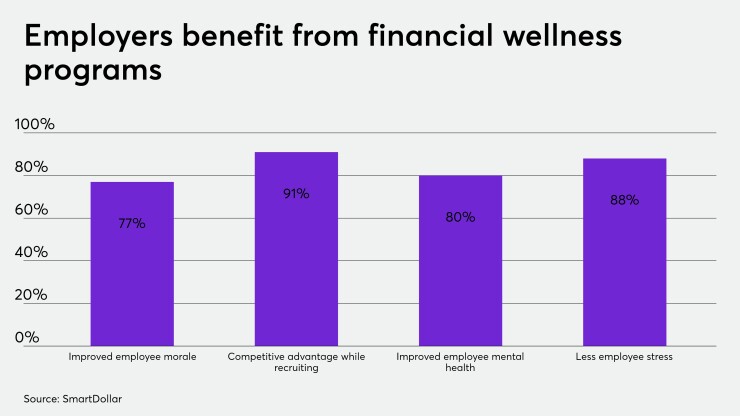More than a year and a half into the pandemic, many employees are still working to build back their financial security.
Employees are continuing to rebound from the volatile stock market and widespread job loss driven by the pandemic, and 41% say they don’t feel in control of their finances, according to MetLife’s 2021 Employee Benefits Trend study. Thirty-five percent say they are struggling to pay their bills every month.
Read More:
This lack of short-term financial security can also impact employees’ futures and can take a toll on employees’ mental well-being. Financial health ranks as a top contributor to poor mental health, with 86% of employees saying finances are a top source of stress for them now and in the future, according to MetLife.
While many employers offer financial resources to their employees — ranging from personal finance workshops to voluntary benefit offerings — few of these resources take into account the emotional and mental aspects of managing one’s money. There are several considerations employers should keep in mind when determining how to best implement employee support that addresses both financial and mental health.
Read More:
Take a personalized approach to improving employees’ financial well-being.
For many employees, short-term and long-term financial security is just one of many stressors. With this in mind, employers should consider financial planning solutions that help satisfy the diverse needs of employees across their workforce.
For example, MetLife’s EBTS study found that 52% of parents are living paycheck-to-paycheck. As children now return to in-person schooling, it’s important for employers to offer tools that can help parents stay on track with their new routines and financial goals. This can make a significant difference in the lives of parents. According to MetLife’s research, working parents who feel in control of their finances are 71% percent more likely to say they feel mentally healthy and 52% more likely to feel resilient than those who do not.
Read More:
Consider the ease and accessibility of financial planning tools.
Unfortunately, employer-offered benefits can sometimes be a point of confusion and frustration for employees. In fact, nearly a third of employees don’t think that their employer’s benefit communications are easy to understand. To minimize stress, it’s important that your financial wellness resources are as convenient and easy to access as possible.
Employers can consider tools like Upwise that act as a one-stop resource to help employees both prioritize their financial goals and budgeting-related stressors — all from their mobile phone. Integrated financial and mental health tools like these, which are convenient for employees to use and access, can help ensure employers’ resources are addressing employees’ anxieties.
Read More:
Implement financial planning tools to improve both employees’ health and workplace success.
Prioritizing employees’ financial and mental health can be beneficial not only for workers, but for employers and their organizations more broadly, too. Just consider that more than a quarter of employees say they’re less productive at work due to financial worries. Unfortunately, this can have a compounding effect on employees, as poor performance at work can lead to loss of promotions and salary increases down the line.
Conversely, when employees feel less financially and mentally strained, they’re more able to focus on their careers, and feel better about their performance at work. MetLife’s EBTS study found that employees who are financially and mentally healthy are 37% more likely to be productive than those who aren’t.
Amid the many changes happening in today’s work-life world, it’s no surprise that employees are feeling anxious about their finances. However, with access to the right financial resources, employers can help their employees get back on track with their financial goals, improve their work performance, and help them feel healthier overall.






